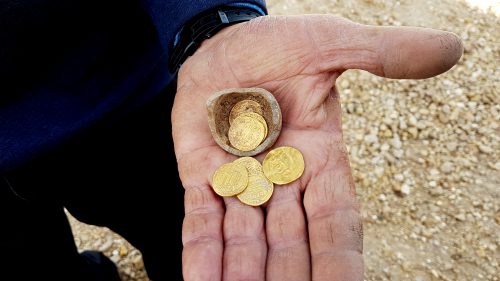The treasure - from the early Islamic period, includes seven coins that were discovered inside a small pottery jar. The archaeologists: "It is possible that this was a potter's personal coffers"

"Hanukkah money" was discovered this weekend in archaeological excavations in Yavne: during inspection excavations by the Antiquities Authority as part of a large-scale project to establish a residential neighborhood initiated by the Israel Lands Authority, the archaeologists were surprised to discover a Pakhit fragment (a small pottery jar), containing gold coins from the early Islamic period (9th century CE ). The excavation revealed a vast industrial area that was active for hundreds of years, and the researchers speculate that the glittering hoard was, perhaps, the coffers of a potter who worked there.
"I was in the container documenting findings, when suddenly I heard screams," says Liat Nadav-Ziv, who manages the excavation together with Dr. Eli Hadad from the Antiquities Authority. I went outside and saw Mark Molkandov, a veteran archaeologist with the Antiquities Authority, running towards the camp, all excited. We rushed after him to the field and were surprised to see the treasure."
From a preliminary examination by Dr. Robert Cole, a coin expert from the Antiquities Authority, it appears that the treasure dates back to the beginning of the Abbasid Caliphate period in the 9th century AD. Among the coins is a gold dinar of the caliph Harun a-Rashid (786 - 809 CE), on which the stories of the Thousand and One Nights were based. "The cache contains coins that we rarely see here in Israel. These are gold dinars of the Haglabi dynasty - local rulers on behalf of the Abbasid caliphs in Baghdad, who ruled North Africa. There is no doubt that this is a Hanukkah gift for us", Kol concludes.
In the excavation, which was conducted southeast of Tel Yavneh, a "kiln field" of unusual scope was uncovered, which operated at the end of the Byzantine and early Islamic periods (9th-7th centuries CE). The gold hoard was discovered in a small pot near the entrance of one of the furnaces, and according to the archaeologists, these coins may have been used as payment to the potter, who stored them in his personal pot.
In another part of the site in Yavne, the remains of a vast industrial facility from the Persian period (5th-4th centuries BC) were uncovered which was probably used to make wine. According to Dr. Hadad, "In the initial tests we conducted, ancient grape seeds were discovered inside the cells of the facility. The size of the cells and the large amount of them in it testify to the production of wine on a commercial scale, far beyond the local consumption of the inhabitants of Old Yavne."

One response
How was an ancient nucleus preserved there after so many years?